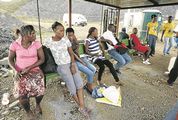PEOPLE who smoke and drink too much, don’t exercise, and eat unhealthily are likely to suffer from noncommunicable diseases, such as heart disease and diabetes. They are also likely to die early.
More than most people, they need counselling on how to change their behaviour. This is important because it can ensure that scarce resources in the public health sector are used more cost-effectively.
But in SA, counselling about noncommunicable diseases and the underlying risk factors has, until recently, been particularly inadequate. Primary care providers are ill-equipped to provide more than ad hoc advice on how to adopt a healthy lifestyle.
More than 38-million people die across the world from noncommunicable diseases every year. There are four groups of diseases responsible for 82% of these deaths: cardiovascular diseases, cancers, respiratory diseases and diabetes.
According to the World Health Organisation, 40% of deaths in the developed and developing world occur in people who are younger than 70. Of these, 82% are in lower-and middle-income countries.
In SA, noncommunicable diseases are among the top 10 leading causes of death. These have been on the increase, driven by risky lifestyle choices.
Although these outcomes can be changed, progress towards prevention has not kept pace with the rising burden of disease. The effect of noncommunicable diseases is felt by the individual patient and their families, communities, and the over-burdened health system.
Research has shown that interventions that target people as part of a family unit and a community are more effective. For example, two 40-year-old men — one married and the other single — but both suffering from diabetes need a counselling approach that takes into account their lifestyles.
In SA, patients will most likely be counselled by public sector nurses or primary-care doctors. Recent studies that assessed healthcare providers’ capacity to deliver behaviour-change counselling show that this service is inadequate in both the public and private sectors.
None of the nurses included in the study and only one-fifth of the doctors had excellent knowledge of the major issues around noncommunicable disease-risk factors. Public-sector nurses accept the role of providing counselling and about one-fifth believe they are knowledgeable. But they may have an inflated perception of their knowledge on how to modify a patient’s lifestyle. Primary-care doctors also accept that they must deliver brief counselling and feel it is important. But they doubt their ability effectively to assist patients to change risky behaviours. Aside from insufficient training, several other factors contribute to their lack of confidence to deliver counselling.
Many have faced several barriers that have discouraged them. These include a lack of patient education materials; time and language constraints; poor continuity of care and record-keeping; conflicting lifestyle messages; and an unsupportive organisational culture.
There is a need to revise the approach to the training of doctors to ensure skills can be learnt and transferred to the clinical setting.
Training for primary care providers in the Western Cape is not sufficient to achieve competence in clinical practice. Training is limited by time constraints, and is not integrated into the curriculum. There is a focus on theory, rather than modelling and practice, as well as a lack of assessment.
To improve the current training programmes, I designed, developed and implemented a best-practice training programme, along with training materials and resources. The programme, piloted in the Western Cape, targeted primary care doctors and nurses.
The training programme is based on a conceptual model that combines the five As: ask, alert, assess, assist and arrange. It is based on a guiding style derived from motivational interviewing, which differs from the traditional directing style of counselling. This guiding style has been widely used internationally.
The programme is designed to target all four risk factors associated with noncommunicable diseases.
Traditionally, primary care doctors have been the expert advice giver. They try to convince patients why, what and how they should change. But in the guiding style, the argument for change is evoked from the patient. This moves the counselling approach from provider-centred to patient-centred.
The programme changed primary care doctors’ approach and provided skills to deliver patient-centred counselling — at least in the short term. And it helped them develop the approach of the guiding style, which they were able to retain in clinical practice.
Delivering it in a clinical environment remains challenging. Training alone is not enough to ensure that better behaviour-change counselling is implemented.
There are still several barriers. These include: under-staffing; lack of managerial support; and poor continuity of care.
To incorporate better behaviour-change counselling into everyday care, a whole systems approach is needed. This requires training primary care doctors to change their counselling behaviour, but also requires change at other levels.
For example, the organisational culture is not congruent with the patient-centred guiding style of better behaviour-change counselling. Asking primary care doctors to embody values of trust, respect and openness in an environment in which they are experiencing manipulation, blame and control, is unrealistic.
Incorporating better behaviour-change counselling into everyday care does not only require training, but also a change in the underlying supportive culture in primary care settings.
• Malan is a senior lecturer in the division of family medicine and primary care at the faculty of medicine and health sciences, Stellenbosch University. This article first appeared on The Conversation























Change: 0.40%
Change: 0.47%
Change: -0.49%
Change: 0.53%
Change: 1.03%
Data supplied by Profile Data
Change: 1.71%
Change: 1.13%
Change: 0.40%
Change: 0.00%
Change: 1.37%
Data supplied by Profile Data
Change: -1.06%
Change: -0.24%
Change: -1.13%
Change: -1.33%
Change: 0.81%
Data supplied by Profile Data
Change: -1.02%
Change: -1.12%
Change: 0.13%
Change: 1.93%
Change: 0.52%
Data supplied by Profile Data